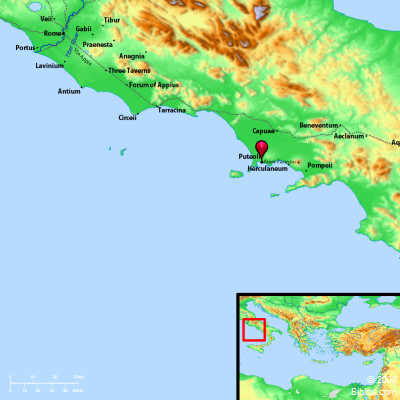Encyclopedia
PUTEOLIpu-te'-o-li (Potioloi, "sulphur springs" (Acts 28:13, Westcott and Hort, The New Testament in Greek), the modern Pozzuoli): A maritime city of Campania, which occupied a central position on the northern shore of a recess in the Gulf of Naples, protected on the West by the peninsula of Baiae and Cape Misenum. It was originally a colony of the neighboring Greek city Cumae.
The earliest event in the history of Puteoli which can be dated definitely was the repulse of Hannibal before its walls by a Roman garrison in 214 B.C. The design of the Carthaginian to secure a seaport as base of supplies and communication was thus thwarted (Livy xxiv. 7, 12, 13). A Roman colony was established here in 194 B.C., and Puteoli thus became the first Roman port on the Gulf of Naples (Livy xxxiv. 45; Strabo v0.245; Velleius, i.15). Its subsequent remarkable prosperity and commercial activity are to be attributed to the safety of the harbor and the inhospitable character of the coast nearer Rome. For Puteoli became the chief seaport of the capital before the creation of an artificial harbor at Portus Augusti by Claudius, and before Trajan made the mouth of the Tiber the principal converging point for the over-sea carrying trade. The imports at Puteoli consisted mainly of Egyptian grain and oriental wares, dispatched from Alexandria and other cities of the Levant (Cicero Pro Rabirio 40; Suetonius, Augustus 98; Strabo xvii. 793; Cicero Pro Caelio 10). The eastern element in the population was very numerous (Petronius 81; CIL, X, 1797). The harbor was rendered doubly safe by a mole, which is known to have been at least 418 yards in length, consisting of massive piers connected by means of arches constructed in solid masonry (Strabo v.245). Extensive remains of this mole still exist. The shore line devoted to purposes of commerce (emporium) extended for a distance of about 1 1/4 miles westward from the mole. At the height of its prosperity under Claudius and Nero, the town is thought to have contained a population of nearly 100,000.
The region in which the town was situated is of volcanic formation, the name Puteoli being due to the odor of the sulphureous springs or to the wells of a volcanic nature which abound in the vicinity. The volcanic dust, called pozzolana today, was mixed with lime to form a cement of the greatest durability, which was weatherproofing against the influence of seawater.
Extensive remains of an amphitheater, whose axes measure 160 and 126 yards across the space enclosed by the outer facade and 75 and 45 yards within the arena, bear testimony to the former affluence of Puteoli.
The region about Puteoli together with Baiae became the favorite resort of the Roman nobility, and the foundations of many ancient villas are still visible, although partly covered by the sea. Cicero's villa in the territory of Puteoli (Cicero Ad Fam. v.15, 2; Ad Att. xiv. 16, 1; 20, 1) was afterward selected as the place of burial of Hadrian (Spartianus Had. 25). The portion of the bay between Puteoli and Baiae was the scene of the attempt made at the instigation of Nero upon the life of his mother by means of a vessel so contrived that it was to break to pieces while conveying Agrippina toward her villa near the Lucrine Lake (Tacitus, Annals xiv.8).
See NERO.
The apostle Paul found a Christian community at Puteoli, when he arrived there on his way to Rome, and stopped 7 days with them (Acts 28:13, 14). At that time the ordinary route to Rome, following the Via Appia from Capua, was 155 Roman, or about 142 1/3 English miles (Nissen, Italische Landeskunde, II, 739). Later, Domitian reduced the distance to 139 Roman miles (about 129 English miles) by laying out the Via Domitia along the coast, joining the Via Appia at Sinuessa (Geog. Raven., IV, 32; Itin. Ant., 122; Tab. Peut.).
George H. Allen
PUTE'OLI, now a seaport of Campania, situated in a small bay, 7 ms. s.w. from Naples, now Pozzuoli bay (pron. pot-soo-o'-lee), 114 ms. s.e. of Rome.
Strong's Greek
G4223: PotioloiPuteoli, a city on the Bay of Naples




